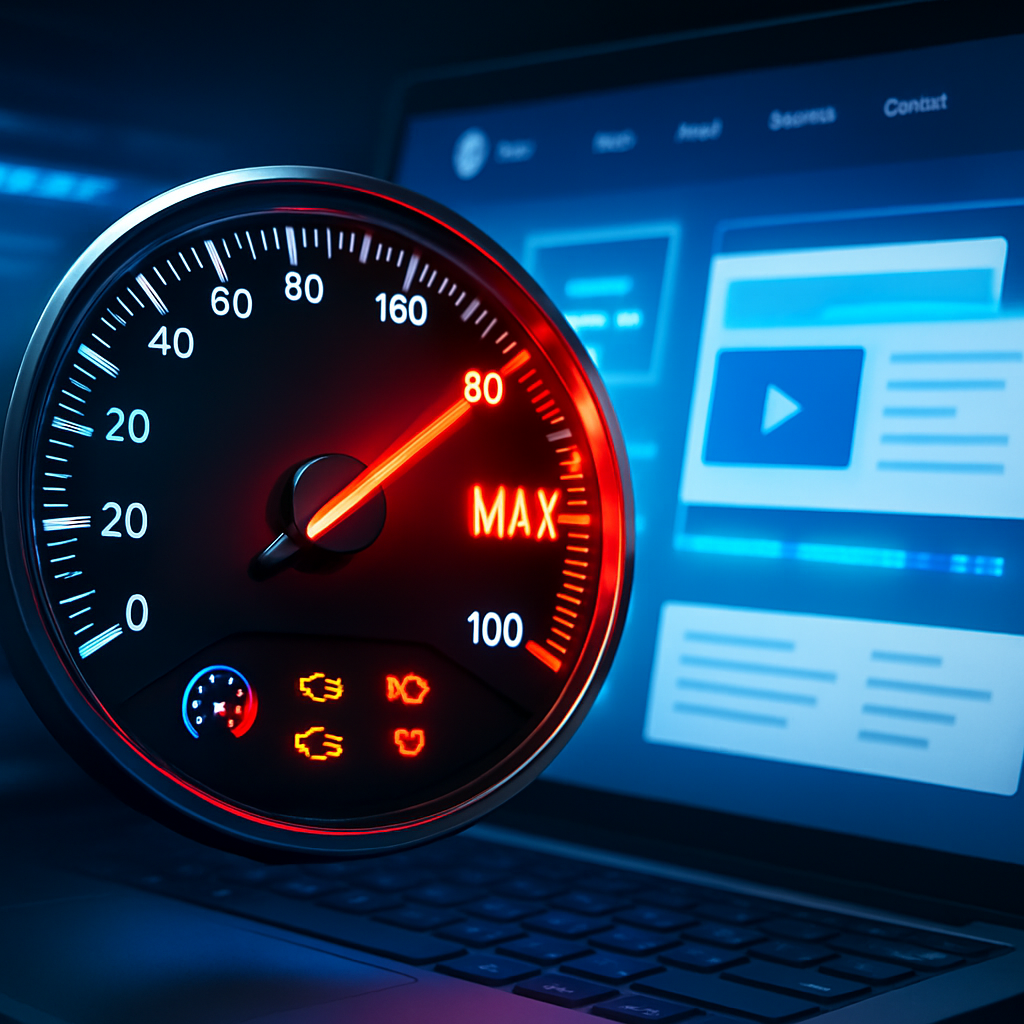Introduction to Web Performance in 2025
Web performance has become more critical than ever in 2025. With users expecting near-instant loading times and search engines prioritizing fast, responsive websites, optimizing your site's performance is no longer optional—it's essential for success online.
Key Statistics: According to recent studies, 47% of users expect websites to load in less than 2 seconds, and 40% will abandon a site that takes more than 3 seconds to load. Additionally, Google's Core Web Vitals have become a dominant ranking factor, directly impacting your site's visibility in search results.
This comprehensive guide will walk you through the latest strategies and techniques to optimize your website's performance in 2025, focusing on Core Web Vitals, image optimization, JavaScript optimization, caching strategies, and more.
Understanding and Optimizing Core Web Vitals
Core Web Vitals have evolved since their introduction, but they remain the foundation of performance measurement. In 2025, these metrics continue to be crucial for both user experience and search engine optimization.
Largest Contentful Paint (LCP)
LCP measures the time it takes for the largest content element (usually an image or text block) to become visible. Google recommends an LCP of 2.5 seconds or less.
To optimize LCP:
- Implement server-side rendering (SSR) or static site generation (SSG) for faster initial content display
- Use resource prioritization (
fetchpriority="high") for critical resources - Optimize and properly size images that may be the LCP element
- Implement efficient CDN caching strategies
- Use modern image formats like WebP and AVIF
- Remove render-blocking CSS and JavaScript
Interaction to Next Paint (INP)
INP has replaced First Input Delay (FID) in 2025 as a more comprehensive measure of responsiveness. It measures the time from when a user interacts with your page to when the browser responds visually. A good INP score is 200ms or less.
To optimize INP:
- Break up long tasks into smaller ones (task chunking)
- Optimize event handlers and limit their complexity
- Use web workers for complex calculations
- Implement progressive hydration for JavaScript frameworks
- Optimize third-party script loading and execution
- Utilize
requestAnimationFrameandrequestIdleCallback
Cumulative Layout Shift (CLS)
CLS measures visual stability by quantifying unexpected layout shifts. A good CLS score is 0.1 or less. Poor CLS creates frustrating experiences when elements move as the page loads.
To optimize CLS:
- Always specify width and height attributes for images and videos
- Reserve space for ads, embeds, and iframes
- Use CSS contain-intrinsic-size for web fonts
- Avoid inserting content above existing content
- Implement content-visibility for off-screen content
- Use modern CSS layout techniques like Grid and Flexbox
Advanced Image Optimization Techniques
Images typically account for 50-60% of a webpage's total size. Optimizing them is one of the most effective ways to improve performance.
Embrace Next-Gen Formats
Modern image formats like WebP, AVIF, and JPEG XL offer superior compression and quality compared to traditional formats. In 2025, browser support for these formats is near-universal.
<!-- Example of using next-gen formats with fallbacks -->
<picture>
<source type="image/avif" srcset="image.avif" />
<source type="image/webp" srcset="image.webp" />
<img src="image.jpg" alt="Description" width="800" height="600" loading="lazy" />
</picture>Implement Responsive Images
Serve appropriately sized images based on the user's device and viewport size using thesrcset and sizes attributes.
<img
src="image-800w.jpg"
srcset="image-400w.jpg 400w, image-800w.jpg 800w, image-1600w.jpg 1600w"
sizes="(max-width: 600px) 400px, (max-width: 1200px) 800px, 1600px"
alt="Responsive image example"
width="800"
height="600"
loading="lazy"
/>Implement Lazy Loading and LQIP
Use native lazy loading for images below the fold and consider Low-Quality Image Placeholders (LQIP) to improve perceived performance.
The native loading="lazy" attribute is now well-supported across browsers. For more control, consider using Intersection Observer API.
Pro Tip: Optimizing Above-the-Fold Images
While lazy loading is great for below-the-fold images, always prioritize loading above-the-fold images immediately using the loading="eager" attribute or by omitting the loading attribute entirely. For Next.js applications, use the priority prop on the Image component for critical above-the-fold images.
JavaScript Optimization Strategies
JavaScript is often the primary cause of performance issues. Optimizing your JavaScript can dramatically improve loading and interaction times.
Implement Code Splitting
Code splitting allows you to break your JavaScript into smaller chunks that load on demand, reducing the initial load time. Most modern frameworks and bundlers support code splitting natively.
// React example with dynamic imports
import React, { lazy, Suspense } from 'react';
// Lazy load components
const HeavyComponent = lazy(() => import('./HeavyComponent'));
function App() {
return (
<div>
<Suspense fallback={<div>Loading...</div>}>
<HeavyComponent />
</Suspense>
</div>
);
}Use Tree Shaking and Dead Code Elimination
Tree shaking removes unused code from your final bundle. Ensure your build process includes proper tree shaking and minification.
With ES modules and modern bundlers like Webpack, Rollup, or esbuild, tree shaking happens automatically when using proper export/import syntax.
Optimize Script Loading
How you load scripts can significantly impact performance. Use appropriate loading strategies based on script criticality.
<!-- For critical scripts -->
<script src="critical.js"></script>
<!-- For non-critical scripts -->
<script src="non-critical.js" defer></script>
<!-- For scripts that don't affect the current page -->
<script src="analytics.js" async></script>Advanced Caching Strategies
Proper caching can dramatically reduce load times for returning visitors and reduce server load.
HTTP Caching
Set appropriate cache headers to allow browsers to store and reuse previously fetched resources.
# Example cache headers in .htaccess
<IfModule mod_expires.c>
ExpiresActive On
# Images
ExpiresByType image/jpeg "access plus 1 year"
ExpiresByType image/webp "access plus 1 year"
# CSS, JavaScript
ExpiresByType text/css "access plus 1 month"
ExpiresByType application/javascript "access plus 1 month"
# HTML - short cache
ExpiresByType text/html "access plus 1 hour"
</IfModule>Service Workers and PWA
Implement service workers to cache resources, enable offline functionality, and create Progressive Web Apps (PWAs).
Service workers act as a proxy between the browser and the network, allowing you to intercept network requests and serve cached resources even when offline.
Content Delivery Networks (CDNs)
Use CDNs to serve static assets from servers geographically closer to your users, reducing latency and improving load times.
Modern CDNs now offer edge computing capabilities, allowing you to run serverless functions at the edge for even faster response times.
When to Use Different Caching Strategies
| Strategy | Best For | Duration |
|---|---|---|
| Browser Cache | Static assets (images, CSS, JS) | 1 month to 1 year |
| CDN Cache | All static content | Variable (based on TTL) |
| Service Worker | Offline functionality, app shell | Until manually updated |
| Memory Cache | Frequently accessed data | Session duration |
Measuring and Monitoring Performance
Regular performance monitoring is essential to identify issues and track improvements.
Key Performance Measurement Tools
- Lighthouse: Built into Chrome DevTools, provides scores and recommendations
- WebPageTest: Detailed performance analysis from multiple locations
- PageSpeed Insights: Combines lab and field data for comprehensive analysis
- Chrome User Experience Report (CrUX): Real-world user experience data
- Web Vitals JavaScript library: For measuring Core Web Vitals in real-time
Continuous Performance Monitoring
Implement Real User Monitoring (RUM) to collect performance data from actual users and identify issues that might not appear in synthetic tests.
Services like Google Analytics 4, New Relic, Datadog, and CloudWatch RUM provide comprehensive monitoring capabilities.
// Example web-vitals implementation
import {onCLS, onFID, onLCP, onINP} from 'web-vitals';
function sendToAnalytics({name, delta, id}) {
// Send metrics to your analytics platform
navigator.sendBeacon('/analytics', JSON.stringify({
name,
delta,
id,
page: window.location.pathname
}));
}
// Monitor Core Web Vitals
onCLS(sendToAnalytics);
onFID(sendToAnalytics);
onLCP(sendToAnalytics);
onINP(sendToAnalytics);Conclusion: The Future of Web Performance
Web performance optimization is an ongoing process, not a one-time task. As we move further into 2025, performance will continue to be a key differentiator for successful websites and applications.
By focusing on Core Web Vitals, implementing proper image and JavaScript optimization, utilizing effective caching strategies, and continuously monitoring performance, you can ensure your website delivers the fast, smooth experience users expect and search engines reward.
Remember that even small improvements can have a significant impact. Start with the optimizations that will have the biggest impact for your specific site, and gradually implement more advanced techniques as you progress.

